Abstract
The development of human capital is an important component in the process of producing a competent yet competitive generation. This was embodied under the quality education cluster of the Sustainable Development Goals (SDGs). Films are one of the mediums in developing good characteristics. It plays an important role as an educational platform that orientates values through the development of holistic characteristics. Although, it is realized that there is a lack of dakwah concept in film making among artists in the respective industry. Hence, this research aimed to analyse the influence of dakwah-based film on the holistic development of human capital. This research will analyse the content of a film using a qualitative approach. Findings from the study were analysed using the CAVDI x pro and ATLAS.ti integration methods. Results attained from this research had shown that films do have a significant influence on the development of human capital in terms of belief, moral values, dress, character building and characteristics.
Keywords: Dakwah-based films, development, human capital, Munafik
Introduction
Human capital development is paramount in generating qualities among individuals. It helps produce a generation with sustainable intellectual power, highly skilled, virtuous, superior identity, competent and innovative (Awang et al., 2020).
Human Capital Development from Islamic Perspective
According to Idris et al. (2019), there are five core elements to be implemented in a balanced and integrated manner through the expansion of thoughts, impulses, feelings, physical and spiritual in human capital development. A study by Yusof and Dwi Sari (2017) highlighted human development’s significance in measuring the quality of society, country and organisation. A sustainable balance that integrates material and non-material elements is significant in producing a holistic individual. The emphasis on the software aspect (which is the formation of attitudes and values) is more important than hardware (physical or skills) to achieve human development goals.
As a result, Fitz-enz (2010) concept appears to be more comprehensive of current Human Resource Developments. Human capital development, according to this definition, is defined as the growth of intellect, productive work energy, a positive attitude, dependability, dedication, learning capacity and creativity. This definition is relevant to human life in the current era, in which technology and human capitalisation are prevalent. According to Abdurezak et al. (2009), the Islamic stance on human capital development is to submit the human soul, including human capital, to Allah SWT. Tawhidic philosophy incorporates all areas of life.
The development of human capital through film
Ahmad (2011) defined Islamic film as the result of the refinement of the essence of various discourses in the field of art in Islam. Thus, a dakwah-based film can be expressed as a work of art in the form of halal products, to begin the production with good intentions through the process of pre-publication, publication and post-publication equipped with Islamic-based content, code of ethics and values. Finally, to aim for the spread of dakwah, pure values and upholding the commandment of good and prevention of evil actions during the process of distribution, screening and audience viewing.
Perdana (2018) mentioned that film is an efficient and effective communication media. The function of media as a medium to convey messages that includes hardware, software, user-ware (method of presentation) and under-ware (the art of presentation) cannot be denied (Ahmad, 2011). The film also serves as an educational platform because it has uniqueness and benefits of its own as compared to other media. In addition to entertainment, the education element can be applied casually while the messages and advice are being conveyed to the audience in a very subtle manner to the extent that it touches their heart. Films are not just a creative creation that depicts real-life in society, but they can also influence thoughts, feelings and even change a person’s behaviour towards doing good and leaving evil actions. (Aini & Suyurno, 2016). This was proven in a study by Abd razzak et al. (2016), Yahaya et al. (2014) and Wan Hamat (2017). Furthermore, Ahmad (2011) added that film and drama are effective elements to spark awareness and realisation.
Problem Statement
The role of film as a powerful platform to convey dakwah is no longer undeniable. Interesting themes and plots are used in films as a medium to defend the teachings of Islam. Maulidah and Fatoni (2019) reinforced this view by implying that the uniqueness among the messages conveyed in a positive dakwah-based film includes an element of brotherhood. According to Perdana (2018), there are four criteria of a positive film which are religious form, inspirational, free from pornography and does not contradict religious values.
Nevertheless, the discussion on film as a medium of dakwah should be seen in a broader framework and scope. Muslim intellectuals should avoid getting caught up in a polemic and endless debates especially on issues of status and terminology (Tengku Mohd Ali, 2019). For example, the term Syariah compliant in films, whereas the more pressing issue is to identify how films can generate human capital development towards the audience. This has an indirect relation to the number of films with Islamic nuances and dakwah being produced. Ironically, the number of dakwah-based genre films is still very low as compared to others (Opir, 2018). Most of the film’s genres produced were based on the concept of love and horror. A paradigm shift is significant so that film producers increase the number of films that incorporate Islamic elements while indirectly upsurging the viewing of dakwah-based genre films among audiences in Malaysia. This will give a positive impact on the sustainability of human development (Mohamad Rasit et al., 2020).
Research Questions
Is human capital development important in producing individual characteristics and personalities?
Why do dakwah-based films play a role as an educational medium?
To what extent do dakwah-based films are significant in developing human capital as one of the elements of SDG?
Purpose of the Study
The purpose of the research is to investigate the influence of dakwah-based film that can be a medium in the formation of a holistic human capital. This can be highlighted through the mapping of the values applied in the plots of the film through the aspects of belief, morals, dressing and characteristics. Thus, this will influence the good characteristics of human capital embedded in SDG.
Research Methods
This study uses qualitative design through content analysis that focuses on human capital development in the film. A film entitled Munafik 1 has been chosen as a sample of the study. Data were analysed through the integrated usage of CAVDI x-pro and ATLAS.ti methods. Cavdix-pro is a computer-aided index of video data that uses the x software to view scenes based on time codes. MPEG Streamclip software version 1.9.2 was also used in this study for data analysis. On another note, systematic and precise data was derived from ATLAS.ti software using Strauss and Corbin’s approach of the coding system and quotation (Anselm & Corbin, 1998).
Findings
Analysis of the Munafik 1 film content found that there are four (4) significant aspects of human capital development, namely the belief doctrine, moral values, dress, character building as well as characteristics. The coding system and quotation approach was used based on visual and verbal from the film. The findings are as follows:
Belief doctrine
In the context of belief doctrine, there are five (5) elements that stood out portraying a strong belief in the commandments of faith. This moulds a sustainable individual into producing a noble personality. The belief codes and descriptions are shown in table 1.
BD = Belief Doctrine
Defending Belief
Analysis from the study also found a scene that showed elements of defending belief (BD 1). This can be seen in Figures 1, 2 and 3 below. Quotations were stated according to the Figures’ chronological order.

Zeti believed that a talisman given by a shaman can protect her family. Adam denied and stood sternly on his belief that only Allah SWT has absolute power.

Dialogue
Adam: Apparently, you (Pak Osman) were the one who put a curse on the villagers for years solely for your wealth gains
Figure 2 shows a scene where Maria handed over her talisman to Adam and he sternly stated that talisman is shirk (a sin of idolatry) that must be avoided. A similar situation was shown in a scene from Figure 3 where Pak Osman had used a demonic power to cause disturbances in the village for the benefit of his greed. Talisman and witchcrafts are heavily weighted sins, and they are highly prohibited in Islam (Muhammad, 2002). This is in line with the verses mentioned by Allah SWT in the Quran:(The Quran, 2001, 4: 116)
Using Versus of Ruqiyyah
The analysis of the study found a scene that displayed the element of belief in the power of Allah SWT (BD 6). This can be explained in Figure 5 based on quotations.
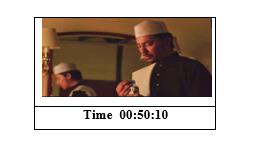
Dialogue
Adam: Bismillahirrahmanirrahin, Allahumma shaliala syaidina muhammad
Figure 3 showed Adam and Azman who came to Maria’s house to perform an exorcism. Maria was possessed by a demon and in consequence, she had a change of character where she became violent with incredible strength. Adam started the exorcism treatment by reciting ruqiyyah verses from the Quran. Finally, with the permission of Allah SWT Maria was herself again. Syaikh Yusuf Ismail an-Nabbani explained in al-Itqan that Ibn al-Matin said, ruqiyyah (spell) and mu’awwidah (verses or prayer for protection) and (99 names of Allah SWT) is a treatment method of a spiritual nature. However, the emphasis of this context is that the healing occurs with the permission of Allah SWT. Then, one is recommended to follow up with a modern treatment (an-Nabhani, 2010). This statement was recorded in an authentic hadith which means: “Mussaddad has narrated to us Abdul Warits from Abdul Aziz he said; “Tsabit and I once visited Anas bin Malik, then Tsabit said; “O Abu Hamzah, I am suffering from a disease.” Then Anas said; “Do you want me to treat you with ruqiyyah of the Prophet SAW?” He replied; “Sure.” Anas said;
Allahumma Rabban Naasi Mudzhibil Ba`sa Isyfii Anta Syaafi la Syaafiya illa Anta Syifaa`an la Yughaadiru Saqama (O Allah the Lord of mankind, the substance that removes pain, indeed you are a Great Healer, no one who can heal but You, that is the healing that does not leave pain (The Hadith, Bukhari, 1997).
Defending the Quran
In this section, analysis of the study found a scene that displayed an element of defending the Quran (BD 7) as shown in Figure 4 followed by an explanation in the form of dialogue.
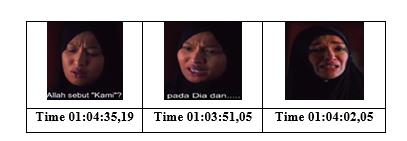
Dialogue
Maria: Why did Allah mention ‘we’? I once dreamt someone told me that the things Allah said refer to HIM and….
Zeti: O Allah! Maria, the one who said that was the Iblis (demon). What is meant by that was the greatness and majesty of Allah SWT.
Figure 4 displays a scene where Zeti stood up for the sanctity of the Quran. She refutes Maria’s opinion who questions the term contained in the Quran based on mere common sense. It is contrary to the hadith that forbids the interpretation of the Quran by opinion and logical reasonings alone. This was narrated in a hadith that stated, “” (The Hadith, Tirmidhi, 2007).
Belief in Allah SWT and His power
The study's findings revealed scenes that clearly demonstrated components of faith in Allah SWT's power (BD 12). This can be explained in Figure 1 and quotation.

Dialogue
Pak Osman: Allah will never love you! What benefits does He give to you? Your wife died! Is it not obvious Adam? Allah has never accepted all your deeds of worship. He does not care or protect you.
Figure 5 shows the scene where Adam went against Pak Osman who was using demonic power to kill him. However, his belief towards Allah SWT has beaten the power of mere creatures. In consequence, Pak Osman went through a horrible death struct by lighting. According to Abu Bakr al-Jassas, only Allah SWT has the absolute power (al-‘Ummadi, A. S., n.d). None can inhibit Allah SWT in showing HIS power. Allah SWT mentioned in the Quran, (The Quran, 2001, 3:26)
Morals (Akhlak)
There are two (2) elements of morals as shown in table 2, that exhibit noble qualities to be applied in life. It shapes the sustainability of an individual in producing a noble personality or also known as. The akhlak code and its’ detailed descriptions are shown in the table below:
Does not contain offensive, abusive, indecent or vulgar dialogue or expressions
Analysis of the study found a scene of warm conversation between Adam and his son Amir uses a polite tone of language (M 2). This can be explained in figure 6 and the quotation below.

Dialogue
Adam: Amir, I might be long gone by the time you grow up. When that time comes, please do not stop visiting the grave because when you do so, it will always remind you of death and the hereafter.
Figure 6 showed a scene of Adam with his son, Amir at the cemetery site. Adam took Amir to visit his mother’s grave while reminding him to always remember about death. Everyone who lives will surely return to its creator one day. He spoke with a good choice of words filled with politeness even though he was still mourning upon the loss of his beloved wife. He reminded Amir to continue the habit of visiting the graveyard even though he is no longer around. Islam demands the believers to speak politely with good language style. It is in line with the hadith of the Prophet Muhammad SAW which means: “” (The Hadith, Bukhari,1997). This highlights the personality of an individual, especially how they interact with children. This sets a commendable example in the sense of interaction demanded in Islam.
Does not display scene(s) that contain attributes of mazmumah (reprehensible)
This study found a scene that showed an admirable act through the scene of Azman who advised his friend Adam to be steadfast and patient after the death of his wife (M 8). This is explained in figure 7 and quotations below.
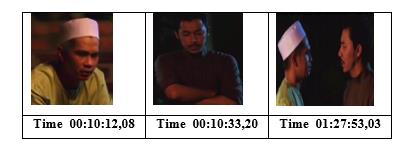
Dialogue
Adam: There is no other place that offers peace but the house of Allah. I know all that Azman. I know it all. But…
Azman: Hey, Adam. Strengthen your faith! Remember, our heart goes back and forth, our faith sometimes goes shaky. We need to be vigilant and careful!
Figure 7 displayed the caring nature of a companion, and this is a manifestation of the act of (noble personality). Azman visited Adam at his house with the intention to provide moral support upon the death of his wife. He advised Adam not to get carried away in mourning of his loss. This nature of caring for each other is very much demanded in Islam as it reveals a sign of faith in Allah SWT to those who practice it. It is also in line with the hadith of the Prophet Muhammad SAW which means: “”. (The Hadith, Bukhari, 1997)
Dress/ Dressing/ Attire
There are two (2) elements of clothing that display the image and identity of a Muslim who is obedient to the requirements of the Shariah. This indirectly shapes the sustainability of an individual in portraying (noble personality). The dress code and detailed description are shown table 3 below.
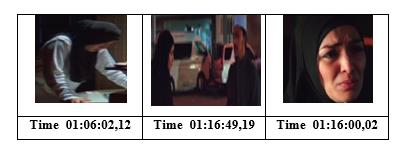
Analysis of the study found that the entire scene involving a male and female cast displayed images of clothing that were shariah-compliant (MD8, MD9, MD10, WD11, WD12, WD13 & WD14). Figure 8 showed some samples of scenes in various locations. This film emphasised a good fashion aspect. The image did not interfere with the storyline but pretty highlighted the character which was held and acknowledged by the audience. Indirectly, it was shown that clothing issue is a technical nature that can wisely be managed. In the context of human capital development, the film Munafik 1 became a role model to the audience to become an obedient Muslim through their attire/ clothing.
Character & Characterisation
There are two (2) elements of character and characterisation that display a good personality when interacting either vertically or horizontally. This directly shapes the sustainability of the individual in portraying (noble personality). The character and characterisation code and its detailed description are shown in the table 4 below.
There was no scene of shaking hands between a man and a non-mahram woman
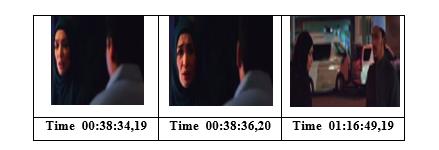
In this section, the study found a scene that involved an interaction between a male and a female cast where no act of shaking hands occurred with the man and the non-mahram woman (C15). This can be illustrated in figure 9 as one of the samples in various scenes. One of the scenes was of Zeti and Fadzli at home while Maria was being treated by Adam. So was another scene where Adam and Zeti were on the hospital grounds. This is parallel with the Islamic principle as regards maintaining honour and dignity as mentioned in the hadith of the Prophet SAW which means: “” (The Hadith, Bukhari, 1997).
The expression of syahadah (declaration of faith) must be perfect without any kind of reduction or expressed in reverse.
The analysis of the study showed a scene where the character of Adam taught his wife; Zulaikha, the expression of the word syahadah (declaration of faith) perfectly at the moment where she was at the brink of death (C19). This can be explained in Figure 8 and the quotation below.
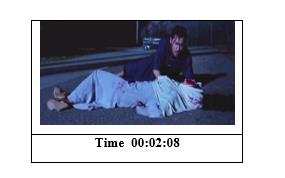
Dialogue
Adam : Asyhadu allaa ilaaha illallah
Zulaikha : Asyhadu allaa ilaaha illallah
Adam : Wa asyhadu anna Muhammadur Rasuulullah
Zulaikha : Wa asyhadu anna Muhammadur Rasuulullah.
Figure 10 showed Zulaikha in a critical situation after being seriously injured in an accident. It was during this moment that Adam taught his dying wife to express the word of syahadah (declaration of faith). Even though Adam was in pain, his character had reflected faith and firm belief in his destiny given by Allah SWT. This is a good example set to the audience that in the sacrament of death, the best thing to do is to teach the person to say the word of syahadah. Expressing syahadah upon death is one of the ways to achieve (a good ending). This coincides with the hadith of the Prophet SAW which means: “” (The Hadith, Abu Daud, 2009).
Conclusion
The outcome of this study concluded that:
Human capital development is significantly possible through good film production. All of the elements discussed in this study directly shape the sustainability of the individual in producing a noble personality () embedded in the quality education cluster of the SDG.
The elements of human development were evident in the film Munafik 1;
The film features noble morals either highlighted through a father’s advice to his son or the moral support of a friend when disaster strikes.
This film highlights the importance of maintaining and defending the faith in Allah SWT from the elements of polytheism. It also educates the community to make the Quran a guide for life.
The film highlights shariah compliance clothing without compromising on the compelling message.
The film provides the best example from the aspect of relationship boundaries between men and women according to Islamic standards.
Acknowledgments
This article is the result of research under the Fundamental Research Grant Scheme (FRGS), with the research title of “Construction of Shariah-compliant Module in Islamic Film and Drama Production in Malaysia.” Code: FRGS/1/2016/SS/UM/02/9.
References
Abd Razzak, M@M, Rahim, S. R., & Siren, N. (2016). Pengaruh Filem Terhadap Akidah Muslim: Analisis Unsur-unsur Syirik dalam Tiga Filem Seram [The Influence of Film on the Muslim Faith: An Analysis of the Elements of Shirk in Three Horror Films]. International Conference on Islamic Jurisprudence (ICIJ). Krabi Front Bay Resort. Krabi.
Abdurezak, A., Hashi, & Bashiir, A. (2009). Human Capital Development from Islamic Perspective. International Conference on Human Capital Development. University Malaysia Pahang.
Ahmad, D. (2011). Menerapkan Nilai Agama dan Keperihatinan Umat dalam Filem dan Drama [Applying Religious Values and Concerns of the People in Film and Drama].
Ahmad, N. (2011). Filem Islam Satu Perbicaraan [Islamic Film: A Trial], Shah Alam. Uni-N Production Sdn. Bhd.
Aini, Z., & Suyurno, S. S. (2016). Pengantar Komunikasi Dakwah [Introduction to Dakwah Communication]. Jabatan Dakwah Kepimpinan (FPI). UKM.
al-‘Ummadi, A. S. (n.d). Tafsir al-‘Allamah Abi Su’ud [Interpretation of Al 'Ulmah Abi S'ad], Vol. 1. Dar al-Fikr.
an-Nabhani, S. Y. I. (2010). Terapi dengan Asmaul Husna [Therapy with Asmaul Husna]. Madani.
Anselm, S., & Corbin, J. M. (1998). Basics of qualitative research techniques (2nd Ed.). SAGE Publications.
Awang, S., Basir, S. A., & Mohamed, H. A. B. (2020). Pelaksanaan Program Pembangunan Modal Insan (PMI) di Institusi Pengurusan Hal Ehwal Islam (PHEI): Kajian Kes di Jabatan Kemajuan Islam Malaysia (JAKIM) [Implementation of the Human Capital Development Program (PMI) at the Islamic Affairs Management Institution (PHEI): A Case Study at the Malaysian Islamic Development Department]. International Journal of Islamic and Civilizational Studies. Skudai: UTM
Fitz-enz, J. (2010). The New HR Analytics: Predicting the Aconomic Value of Your Company’s Human Capital Invesments. United States of America.
Idris, M., Wan Zakari, W. F. A., Long, A. S., & Salleh N. (2019). Pembangunan Modal Insan (PMI) dari Perspektif Islam [Human Capital Development from an Islamic Perspective]. Journal of Management and Operation Research, 1(2).
Maulidah, L., & Fatoni, U. (2019). Dakwah Persaudaraan Islam dalam Short Movie [Islamic Brotherhood Da’wah in Short Movie]. Jurnal Kajian Dakwah dan Kemasyarakatan, 23(2). UIN Syarif Hidayatullah.
Mohamad Rasit, R., Misrom, A., & Hamjah, S. H. (2020). The Level of Audience Acceptance of Islamic Genre Film. Academic Journal of Interdisiciplinary Studies, 9(4). Richtman Publishing.
Muhammad, S. A. A. (2002). Tamhid li Sharh Kitab al-Tauhid (Vol 1.). Dar Tauhid.
Opir, H. (2018). Filem Berunsurkan Dakwah di Malaysia: Kajian dari Aspek Pematuhan Syariah [Dakwah -Based Films in Malaysia: A Study from the Aspect of Shariah Compliance]. Universiti Malaya.
Perdana, K. (2018). Nasib Film Islami di Negeri Mayoritas Muslim. Dalam Republika Online. Dari [The fate of Islamic films in Muslim-majority countries. In Republika Online]. https://www.republika.co.id/berita/nasional/news-analysis/18/04/19/p7fj6G415-nasib-film-islami-di-negeri-mayoritas-muslim
Tengku Mohd Ali, T. I. M. (2019). Menelusuri Pengajian Melayu: Siri Ilmiah, Institut Terjemahan dan Buku Malaysia: My Era Cetak Sdn. Bhd. [Exploring Malay Studies: Scientific Series, Malaysian Institute of Translation and Books].
The Hadith (‘Eisa At-Tirmidhi, A. E. M., Trans.) (2007). Darussalam, Riyadh, Saudi Arabia.
The Hadith (Abi Dawud, S., al-Ashʿath al-Sijistani al-Azdi, A. D. S., Trans.) (2009). Dar al-Risalah al-ʿAlamiyah, Beirut.
The Hadith (Muhsin Khan, M., Trans.) (1997). Sahih Bukhari, Darussalam, Riyadh, Saudi Arabia.
The Qu’ran (Basmeih, A., Trans.) (2001). Darul Fikir Kuala Lumpur.
Wan Hamat, W. N. (2017). Pengaruh Media Massa Terhadap Penampilan Akhlak Pelajar Islam Politeknik Malaysia, [The Influence of Mass Media on the Moral Appearance of Malaysian Polytechnic Islamic Students]. The Online Journal of Islamic Education.
Yahaya, A., Gooh, L, Lee, & Ma'alip, H. (2014). Pengaruh Media Berunsur Agresif dan Kesannya Terhadap Tingkahlaku Pelajar Sekolah Menengah [The Influence of Aggressive Media and Its Effect on the Behavior of Secondary School Students]. Proceeding of National Action Research Conference.
Yusof, A. A., & Dwi Sari, M. (2017). Pembangunan Modal Insan daripada Persepektif Islam: Impak Kepada Pengurus [Human Capital Development of Islamic Perspective: Impact to Manager]. Malaysian Journal of Sosial Sciences and Humanities, 2(1).
Copyright information

This work is licensed under a Creative Commons Attribution-NonCommercial-NoDerivatives 4.0 International License.
About this article
Publication Date
31 October 2022
Article Doi
eBook ISBN
978-1-80296-958-0
Publisher
European Publisher
Volume
3
Print ISBN (optional)
-
Edition Number
1st Edition
Pages
1-802
Subjects
Multidisciplinary sciences, sustainable development goals (SDG), urbanisation
Cite this article as:
Abdullah, W. Y., bin Opir, H., & Muhammad Arif, E. E. (2022). Development Of Human Capital Through Dakwah-Based Films: An Analysis Of Film Munafik-1. In H. H. Kamaruddin, T. D. N. M. Kamaruddin, T. D. N. S. Yaacob, M. A. M. Kamal, & K. F. Ne'matullah (Eds.), Reimagining Resilient Sustainability: An Integrated Effort in Research, Practices & Education, vol 3. European Proceedings of Multidisciplinary Sciences (pp. 488-500). European Publisher. https://doi.org/10.15405/epms.2022.10.47

